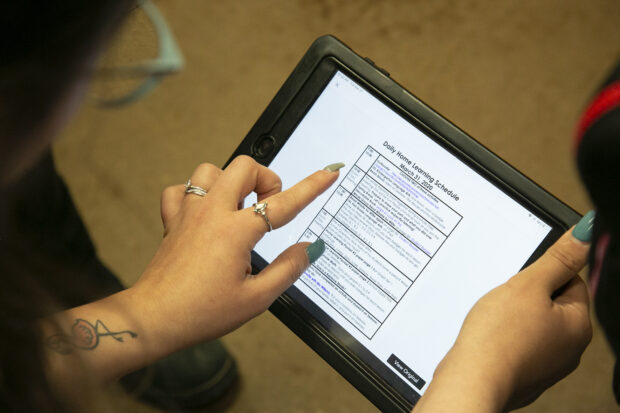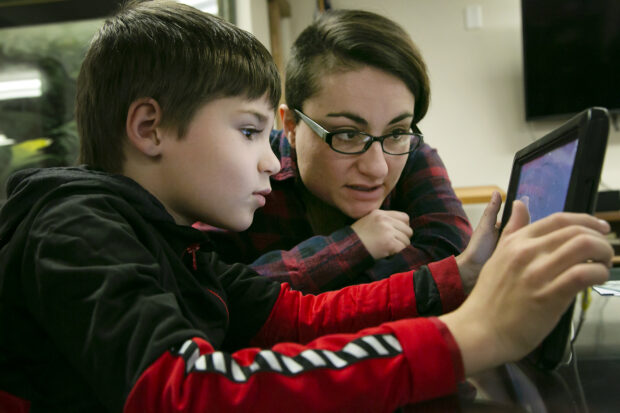As Luke, 7, sorted consonants and vowels into buckets on a touch screen, a steady stream of chatter spilled from his mouth.
“That’s easy. See, it’s OK. Four in a row. Ooooh, that’s harder. No? Okay, that’s a little bit wrong.”
He stomped his feet. Sang to himself. Shifted in his chair. Talked.
Fidgets aside, the first-grader mostly kept his eyes glued to his school-issued iPad on Tuesday morning as he moved through lessons prescribed by his teacher at Nampa’s Willow Creek Elementary. He seemed oblivious to conversations in the hallway behind him, the cry of a baby, or the unusual circumstances of his learning environment: a conference table at the Valley Women & Children’s homeless shelter, where he stays with his mom.
“He laughed at me yesterday when I told him he was going back to school tomorrow, and that he was doing school here,” said Paxton Core, who coordinates Nampa children’s programs for the Boise Rescue Mission.
“It’s for real,” she told Luke. “Your new teachers are Ms. Mom and Ms. Paxton.”

The Nampa School District’s 14,000 students started lessons on computers and iPads on Tuesday, the district’s first day of online learning during coronavirus-related school closures.
The pivot to digital learning has raised concerns in some districts about how to reach students without appropriate devices, internet access or learning accommodations.
More than half of students in the Nampa School District are low-income. The district serves 1,100 homeless youth. Yet, it was the first large district in the state to announce it would launch digital learning, buoyed by the fact that the district already provides a computer or an iPad for every student.
As the online education rollout continues, the district is reaching out to families who face higher obstacles to online learning — like poor internet access or language barriers — to work through any individual challenges, federal programs director Heidi Rahn said. On Tuesday, Rahn was working out a plan for how the district could help students who don’t live in a home with electricity, but need to charge their devices.
To accommodate internet issues, the district set up WiFi access from the parking lots of district schools, sent out more than 100 internet hotspots and plans to deliver more.
Core said she’s been impressed by the district’s plan. Nampa staff is frequently in touch with her, she said, and they’re working to get a hotspot to the shelter to give students a stronger internet connection than is currently available.
“I feel like they have the resources that they needed to be able to take on something like this,” Core said. “They just needed to be able to make a plan, and they even did that rather quickly.”
Nampa School District spokeswoman Kathleen Tuck said online feedback was mostly positive during Tuesday’s launch. Parents posted pictures of the day on the district’s Facebook page.
“Generally, it’s encouraging,” Tuck said. “Of course there’s still a learning curve, but I think we’re in an excellent position as far as being as prepared as you can possibly be for something like this.”
Right now, online learning is slated to continue through April 20, the end of a statewide closure ordered by the State Board of Education. The state board is considering extending that closure through at least the end of April.
The long-term outcome of Nampa’s distance-learning experiment has yet to be seen. But, for one boy, in one homeless shelter, surrounded by a network of caring adults, the process got off to a relatively smooth start.
Luke has lived with his mom, Raquel Mendes, in the Boise Rescue Mission’s Valley Women & Children’s shelter for the better part of a year. Mendes works most days of the week at a local Walgreens. When she’s at work, Luke goes to school, then takes a bus back to the shelter where he does homework with Core and other kids.
As an emergency shelter, Valley is typically closed during the day. But in response to the COVID-19 crisis and Gov. Brad Little’s order that Idahoans stay-at-home, the Boise Rescue Mission is allowing guests to shelter-in-place at the emergency shelter. That means Luke has a warm, safe place to stay and do his homework while schools are closed.
“Luke is the kind of kid who is routine, who has to be routine,” Mendes said. “I’m glad the teacher was able to give us his tablet so he can still do his homework.”
On Tuesday morning, Core and Mendes navigated Luke’s homework together. Core helped the family log onto the Boise Rescue Mission WiFi on Luke’s tablet. Then she and Mendes read through his to-do list for the day: a list of game-like digital lessons, Zoom meetings with the class, readings and work in a paper packet.
Mendes was off work on Tuesday, so she sat down with Luke to get started. When Mendes works, Core will help him through the lessons.
“I don’t have very many people to watch my son when I work, and not have to worry is he doing his homework? Is he reading? Did someone get him to make sure he got off the bus on time?” Mendes said. “It takes a weight off my shoulders.”

